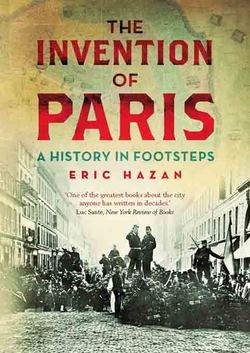The Invention of Paris

Реклама. ООО «ЛитРес», ИНН: 7719571260.
Оглавление
Eric Hazan. The Invention of Paris
The Invention of Paris: A History in Footsteps
Contents
Preface to the English-Language. Edition: A Few More Wrinkles
Acknowledgements
1. Psychogeography of the Boundary
2. Old Paris: The Quarters
THE RIGHT BANK QUARTERS. Palais-Royal
Carrousel
Tuileries-Saint-Honoré
Bourse
The Arcades
Les Halles
Sentier
Marais
The Grands Boulevards
THE LEFT BANK QUARTERS. The Left Bank Boulevards
The Latin Quarter
Odéon
Saint-Sulpice
Saint-Germain-des-Près
Faubourg Saint-Germain
Haussmann’s cuttings
3. New Paris: The Faubourgs
The Wall of the Farmers-General
THE RIGHT BANK FAUBOURGS. Champs-Élysées
Faubourg Saint-Honoré
Faubourg Saint-Antoine
Popincourt and Faubourg du Temple
Faubourg Saint-Martin and Faubourg Saint-Denis
Faubourg Poissonière and Faubourg Montmartre
Saint-Georges and Nouvelle-Athènes
Quartier de l’Europe
Plaine Monceau
THE LEFT BANK FAUBOURGS. Faubourg Saint-Marcel
Faubourg Saint-Jacques
Montparnasse
For Carco:
4. New Paris: The Villages
THE LEFT BANK VILLAGES
Vaugirard and Grenelle
Plaisance
Denfert-Rochereau and the 14th Arrondissement
The 13th arrondissement, Butte-aux-Cailles, the Italie quarter
THE RIGHT BANK VILLAGES
Passy and Auteuil
Batignolles and Clichy
Montmartre
Clignancourt
Goutte d’Or
La Chapelle and La Villette
Buttes-Chaumont
Belleville and Ménilmontant
Père-Lachaise and Charonne
Bercy
The Zone
PART TWO. Red Paris
5. Red Paris
The Birth of the Barricade
Victor Hugo’s Redemption
PART THREE. Crossing the Swarming Scene
6. Flâneurs
7. The Visual Image
Index
Отрывок из книги
The Invention of Paris
Translated by David Fernbach
.....
The mother house of the order of Knights Templar, founded in Jerusalem in the twelfth century, was located at the far end of the region’s major north-south axis, on Rue du Temple.66 Its lands fell into two distinct sections. The heart was the enclos, a fortified quadrilateral whose boundaries would now be Rues du Temple, de Bretagne, Charlot and Béranger. At the centre of this enclosure was the keep, used as a prison for Louis XVI and his family after 10 August 1792, and later for Babeuf and Cadoudal. A large part of the enclosure was rented out to artisans, exempt here from tax as in all the religious precincts of the city.
To the south and east of the enclosure, the Templars possessed large tracts of agricultural land: this was the censive, whose limits defined a further quadrilateral, extending to Rue du Roi-de-Sicile and thus corresponding to a large section of the Marais today. The wall of Philippe Auguste cut through this censive, along the line of Rue des Francs-Bourgeois.67 On the side facing the city, these lands were gradually populated along the axes, particularly along Rue Vieille-du-Temple, which was then called Rue de la Couture-du-Temple [couture = cultivation], but on the outward side there was nothing but market gardens until the sixteenth century.
.....